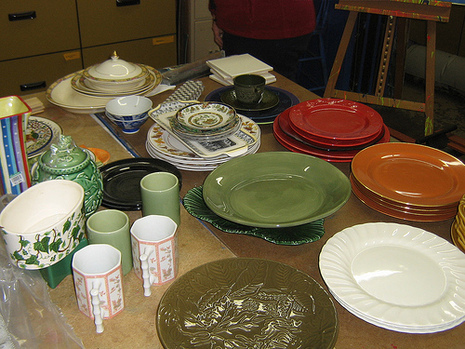OK friends, one of the reasons I’ve been absent from writing much lately is that I’ve been working on a HUGE mural: a wall mounted mosaic commission for a coffee shop that’s being constructed in my neighborhood! Exciting!
So I’m going to lead you through the process of building a giant mosaic installation of your very own.
Since it’s not installed yet, I’m gonna break it into a few parts (just like you break a plate, ha!)
1. Planning and purchasing
2. Breaking and Creating
3. Finishing and Installing!
Now, I’m working with the owner of the coffee shop on the design, and you’ll probably be doing this for your own self, so some of the steps may not apply. But you’ll get the idea!
So. One of the first steps is to determine your design. The space I’m designing for is 10 feet long by 6 feet high. Good thing for us, the backer board I’m using comes in 3×5 sheets! The folks who are refinishing the coffee shop have agreed to finish out the wall by applying plywood to that wall, instead of drywall. We are going to directly screw the backer boards to the walls, and I’m going to go back in after installation and cover the screws with tiles. This saves us from having to find the studs and all.
IF YOU ARE GOING TO DO THIS: make sure to take into account all the weight of your finished piece and how you are going to install it. You don’t want it coming off the wall accidentally once you’ve put all this work into it, do you?
Nikki (the coffee shop owner) and I went through several design ideas. The one that we decided upon, was a group of coffee cups floating in a sea of paisley shapes. Note: this is just a rough idea of the finished project-it’s ending up that I’m using a lot more color than you can see in this sketch.

I created my design in photoshop, and then used the ‘stained glass’ feature to get the look of mosaic tiles broken up.
Nikki gave me several boxes of tiles that she had used for previous projects, and I also purchased a lot of plates from resale shops and Goodwill stores in my area. Fortunately for me, New Year’s Day everything at Goodwill was half-off, so I made out like a bandit. I had to remember that I am covering 60 square feet of space, and every plate will lose about 10% of its overall area once it’s broken. And since I’m using some plates for their borders alone, I had to take that into account as well.
I chose plates based on their texture, color, and overall size. My coffee cups are all white with a patterned border, and the paisleys are all different colors, avoiding the use of white. I’m going to grout the cups in white and the background in grey to help the cups pop and the paisleys receed
Lastly, I had to get my backer-board. I’m using Durock cement board, which as I said, comes in 3×5 sheets. My dad and I cut it down using the correct saw blade, ventilators, and eye protection. A lot of really nasty dust comes out when you cut those things down, so be careful. It’s a lot eaiser to handle a smaller sheet than 3×5, but your design may vary. I laid it out in my mom’s studio and started to sketch out my rough design.

I’m choosing to do the work on a flat surface, because we’re going to screw the panels to the wall. It is possible to do a mosaic installation on a vertical surface, but I find this way to be MUCH easier.
Lastly: before you begin, you need the following tools and supplies:
Tile adhesive. I’ve been using two different kinds, a type called thinset that has a grittier feel, and another all-purpose tile adhesive. I like them both for different reasons-you may just have to get a small container of each and see which you prefer.
Saftey goggles, gloves, and an apron. Self-explanatory. DO NOT CUT TILES OR PLATES WITHOUT PROTECTION.
Tile nipper, go for the heavy duty kind. It’ll set you back about $20 but it’s worth it. Plates will be thicker at the rims and the foot (the circle on the bottom) than your average tile, you’ll appreciate the power the heavy-duty nipper gives you.
Plastic bags for sorting your plates/tiles
Plastic sheeting to protect surfaces and keep the tiles from flying around
Cardboard boxes, same as above
Trowel, putty knife, and palette knife, for spreading adhesive
HAMMERS! Ball peen and rubber mallets are also nice to have.
You also need a space to work where you can lay your materials out and let them sit undisturbed while the adhesive dries. It must be well above freezing, or it will not work.
NEXT UP: Breakin’ up ain’t hard to do!
